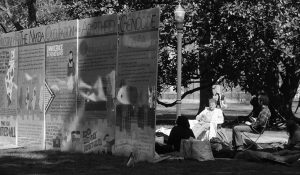Ania Szczesniewski is a junior in the College of Arts and Science. She can be reached at [email protected].
You’re watching your waistline, you’re milking your meal plan, you’ve got butterflies before a test and can’t swallow another bite–whatever your reason, we’ve all stood at a dining hall tray return and sent leftover food to the landfill. As someone who spent the better half of a semester living off of the leftovers of her peers (and still scavenges occasionally), I have witnessed how much food the average Vanderbilt student tosses out.
Well what’s a few chunks of honeydew and a muffin bottom? Actually, lots of the scraps are more like entire entrees and often feel fresh, even lacking bite marks. But regardless if it’s a melon rind or a slice of delectable cheesecake, Vanderbilt’s post-consumer food waste at one cafeteria amounts to something like 593.25 lbs a day–at least that’s exactly how much post consumer food waste was collected by Vanderbilt Food Justice and SPEAR volunteers on Thursday, March 23rd at the Commons Cafeteria tray return.
From 7 a.m. to 8 p.m. that day, there were always at least a pair of volunteers directing diners to scrape the food off their plate into big black trash bins before sending their trays to the dishwasher. Though collecting the leftovers became a mad rush to prevent traffic jams during peak lunch hour–the shift I worked–there was no vocal resentment about the data collection. Instead, most people asked questions and reacted positively when they heard that we are trying to raise awareness about post-consumer food waste and have some hard data that may support or inspire future projects, like Vandy composting. These numbers will both prove the need for composting as well as help administrators anticipate what kind of quantities the compost program would have to deal with.
This day-long event was called Scrape Your Plate Day. Though the idea was originally the brainchild of University of Colorado-Boulder students, members of SPEAR and VFJ were inspired to bring it to Vanderbilt and worked with Dining Administration to make it happen. The hope is to make Scrape Your Plate Day either annually recurring or once a semester so that we can learn more about food waste trends at Vanderbilt over time. UC-Boulder has been doing this for 10 years, now conducting the event three times a semester, and the school has seen a decrease in consumer food waste. According to their website, during dinner in 2010, students wasted 0.42lbs per person, but in 2016 this dropped to 0.16lbs per person. That’s a 62% decrease.
In many ways, it’s hard to compare UC-Boulder to Vanderbilt. They have over 27,000 undergraduates; we have about 7,000. They have an all-you-can-eat cafeteria; we have a fixed entree and sides system. Though we surely produce less waste cumulatively than they do, based on the one day of data collection in which 1888 people ate at the Commons, 0.3 pounds of food were wasted per Commodore card swipe. That’s double the pounds per person wasted at UC-Boulder as of 2016.
Scrape Your Plate was hosted at the Commons Center because the logistics at Rand would have been a nightmare. At Commons there is a single tray return and there isn’t a to-go option. Since Rand has multiple return locations and to-go is popular, gathering accurate post-consumer waste data would be unrealistic. Furthermore, there is a key difference in Rand’s and the Commons’ infrastructure which makes the Commons’ food waste management more sustainable: that infrastructure is a pulping system. Scrape Your Plate Day at the Commons meant pre-pulped weight could be compared to its dehydrated, shredded pulp form. Let me explain:
If you’re at Rand, your uneaten side will be swiped into a trash bag as is. At Commons, a slightly different journey lies ahead because there they have a pulping system. First the conveyor belt carries the trays behind the scenes. Any leftover food is scraped into a trough that runs alongside the belt. Every so often, a gush of water will surge through the trough, pushing all the food into a big cylindrical container at the end. There, a person will occasionally grab what looks like an oar for churning the soup of waste around and around. Once that receptacle is filled, it drains through a series of pipes and the contents gets dehydrated so that all that pops out of a chute in the basement is a dense pulp that’s more reminiscent of shredded magazines than extra pizza slices and salad greens.
The pulping process minimizes the volume taken up by waste in the landfill by ridding it of its liquid content. After the March 23 Scrape Your Plate event, students hoped to quantify how much volume the pulper actually diverts away from landfills by comparing the weight of food they’d collect to the weight of that same food after being pulped. They discovered that the kitchen scraps also go in the pulper, which is a good thing for the environment, but meant that we couldn’t isolate the consumer waste. Without only the weight of the consumer food waste in pulp form, there was no way of knowing just how much volume of student leftovers was prevented from entering a landfill.
In the end, it’s important to remember that regardless of the amount of space it takes up, every time you pay for food going in the trash instead of your mouth, you’re buying realty at the dump. It is my hope that these numbers will raise consumer consciousness about taking only what you need or picking sides that could be portable snacks for later. Most of all, acknowledging that this is waste from only one campus eatery should act as compelling evidence for the usefulness of a composting program here. Currently students are not only disposing of edible food, but they are also tossing organic resources out. Those banana peels, every sweet potato skin… It’s only waste once it’s wasted.











